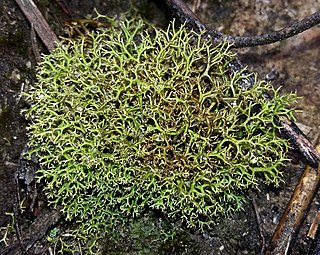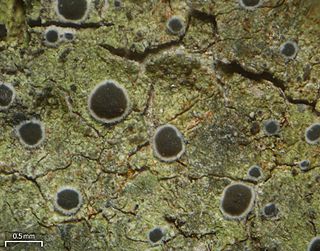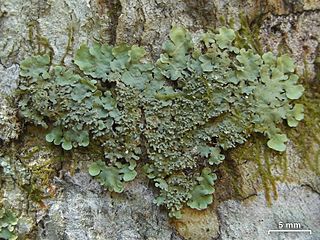
Peltigera is a genus of approximately 100 species of foliose lichens in the family Peltigeraceae. Commonly known as the dog or pelt lichens, species of Peltigera are often terricolous, but can also occur on moss, trees, rocks, and many other substrates in many parts of the world.

Lobaria is a genus of foliose lichens, formerly classified in the family Lobariaceae, but now placed in the Peltigeraceae. They are commonly known as "lung wort" or "lungmoss" as their physical shape somewhat resembles a lung, and their ecological niche is similar to that of moss.

The Peltigeraceae are a family of lichens in the order Peltigerales. The Peltigeraceae, which contains 15 genera and about 600 species, has recently (2018) been emended to include the families Lobariaceae and Nephromataceae. Many Peltigeraceae species have large and conspicuous, leathery thalli. They largely occur in cool-temperate to tropical montane climates. Tripartite thalli involving fungus, green algae and cyanobacteria are common in this family.

Sticta is a genus of lichens in the family Peltigeraceae. The genus has a widespread distribution, especially in tropical areas, and includes about 114 species. These lichens have a leafy appearance, and are colored brown or black. Sticta species with cyanobacteria as photobionts can fix nitrogen from the atmosphere, and due to their relative abundance and high turnover, they contribute appreciably to the rainforest ecosystem. They are commonly called spotted felt lichens.

Acanthothecis is a genus of lichen-forming fungi in the family Graphidaceae. The genus was circumscribed by Frederick Edward Clements in 1909.

Cladia is a genus of lichenized fungi in the family Cladoniaceae. Cladia species have a crustose primary thallus and a fruticose, secondary thallus, often referred to as pseudopodetium. The type species of the genus, Cladia aggregata, is widely distributed, occurring from South America, South Africa, Australasia and South-East Asia to southern Japan and India. Most of the other species are found in the Southern Hemisphere.

Byssoloma is a genus of leaf-dwelling lichens in the family Pilocarpaceae.

Pyxine is a genus of foliose lichens in the family Caliciaceae. The genus has a widespread distribution in tropical regions.
Norrlinia is a genus of two species of fungi in the family Verrucariaceae. The genus was circumscribed by Ferdinand Theissen and Hans Sydow in 1918. The genus name honours the Finnish botanist Johan Petter Norrlin. Both species are lichenicolous, meaning they parasitise lichens. The host of both fungi is the foliose genus Peltigera.

Gyalecta is a genus of fungi in the family Gyalectaceae that contains 50 species. Gyalecta was circumscribed by lichenologist Erik Acharius in 1808.

Architrypethelium is a genus of lichen-forming fungi in the family Trypetheliaceae. The genus was circumscribed in 1991 by Dutch lichenologist André Aptroot, with A. seminudum assigned as the type species. It is a segregate of genus Trypethelium.

Astrothelium is a genus of corticolous (bark-dwelling) lichens in the family Trypetheliaceae. The genus was circumscribed in 1824 by German botanist Franz Gerhard Eschweiler, with Astrothelium conicum assigned as the type species.

Imshaugia is a genus of seven species of foliose lichens in the family Parmeliaceae. They are commonly known as starburst lichens.

Lobariella is a genus of lichens belonging to the family Peltigeraceae.

Bathelium is a genus of lichen-forming fungi in the family Trypetheliaceae. The genus was circumscribed in 1803 by Swedish lichenologist Erik Acharius, with Bathelium mastoideum assigned as the type species.
Sticta rhizinata is a species of foliose lichen in the family Peltigeraceae. Found in Colombia, it was formally described by Bibiana Moncada and Robert Lücking in 2012. It is a member of the Sticta weigelii species complex. The type specimen was collected in Chingaza National Natural Park (Cundinamarca) at an altitude of 3,430 m (11,250 ft). The lichen is only known to occur in the Andes of Colombia at altitudes between 2,300 and 3,720 m. Here it grows on the ground, often associated with bryophytes of the genera Plagiochila, Frullania, Metzgeria, Campylopus, and Dicranum. Frequent lichen associates include Everniastrum, Hypotrachyna, and Peltigera. The specific epithet rhizinata refers to its conspicuous rhizines.
Lobariella robusta is a species of foliose lichen in the family Peltigeraceae. Found in Hawaii, it was formally described as a new species in 2017 by lichenologists Robert Lücking Bibiana Moncada and Clifford Smith. The type specimen was collected by Smith from the Keck Observation Headquarters (Waimea) at an elevation of 822 m (2,697 ft). Here, in a mesic habitat with open-landscaped parkland, the lichen grows on tree trunks. Its thalli, closely attached to their substrate, are up to 5 cm (2 in) in diameter with a smooth, light green upper surface colour that becomes pale green-grey to yellowish grey after drying. It is only known to occur at the type locality. Secondary chemicals that are found in the lichen include pseudocyphellarin A, 4-O-methyl-gyrophoric acid, and gyrophoric acid. The specific epithet refers to the "rather robust, leathery thallus".

Emmanuelia is a genus of lichen-forming fungi in the subfamily Lobarioideae of the family Peltigeraceae. It has 12 species. It was circumscribed in 2020 by Antoine Simon, Robert Lücking, and Bernard Goffinet. They assigned Emmanuelia ravenelii as the type species, reasoning "this is probably the best-documented species of the lineage and its identification is straightforward". The genus name honours Belgian lichenologist Emmanuël Sérusiaux, "for his extensive contributions to advancing our understanding of the diversification of the Peltigerales".

Crocodia is a genus of foliose lichens in the family Peltigeraceae. It has eight species. The genus has a cosmopolitan distribution, although most species occur in temperate and tropical regions of the Southern Hemisphere. The main characteristics of the genus that separate it from its parent genus, Pseudocyphellaria, include a yellow medulla and yellow pseudocyphellae on the lower thallus surface.
Dendriscosticta is a genus of foliose lichens in the family Peltigeraceae. The genus was circumscribed in 2013 by lichenologists Bibiana Moncada and Robert Lücking with Dendriscosticta wrightii assigned as the type species. The genus, a segregate of Sticta, was created to contain species in the Sticta wrightii clade. Dendriscosticta has a sister taxon relationship with the genera Yoshimuriella and Lobariella. Dendriscosticta is distinguished from Sticta by the presence of algae in the excipulum.















